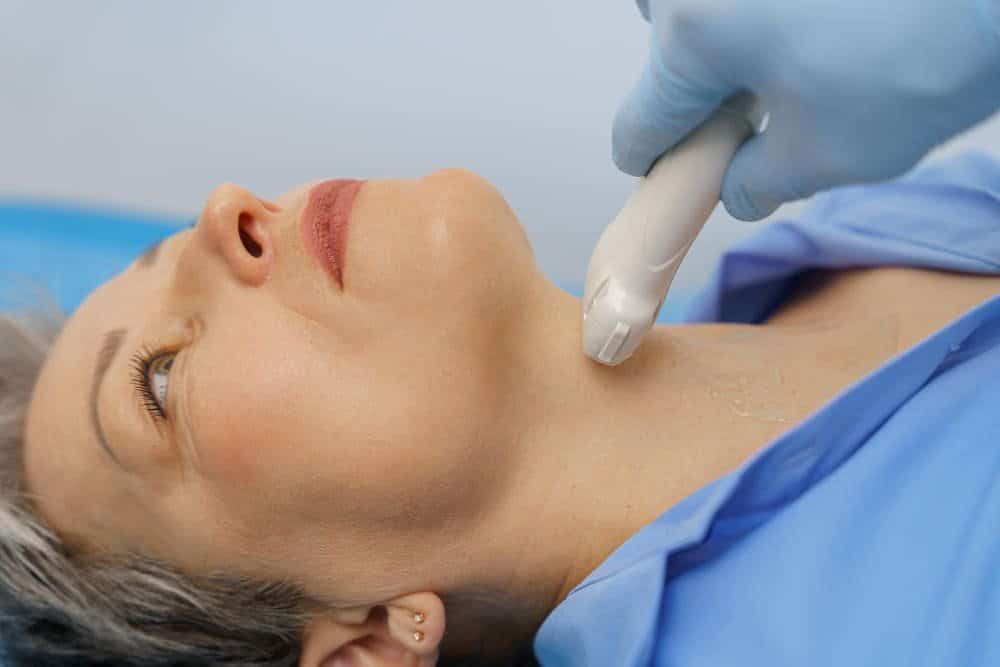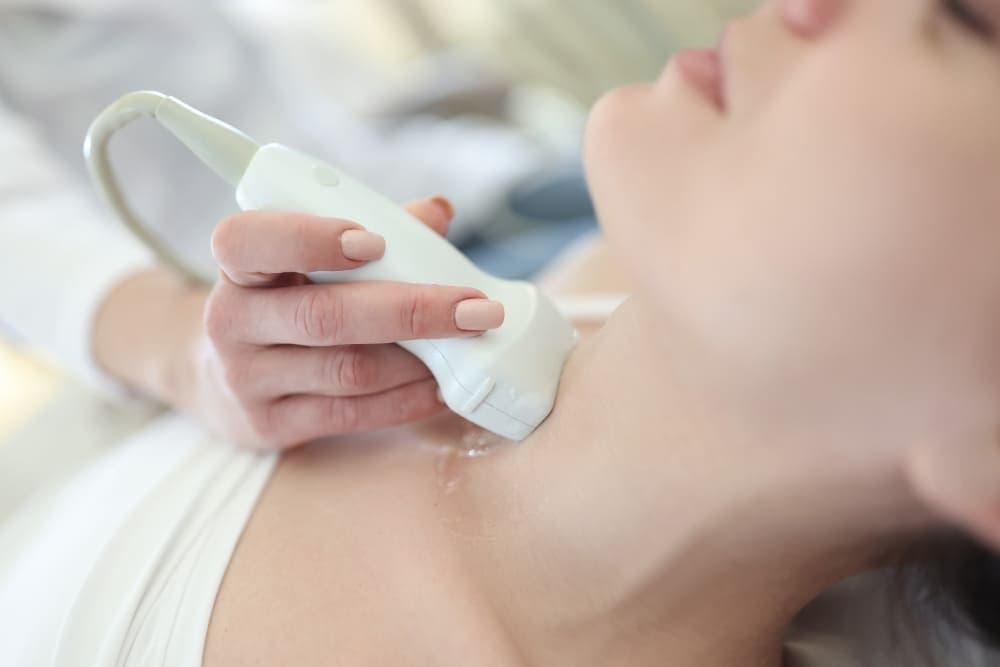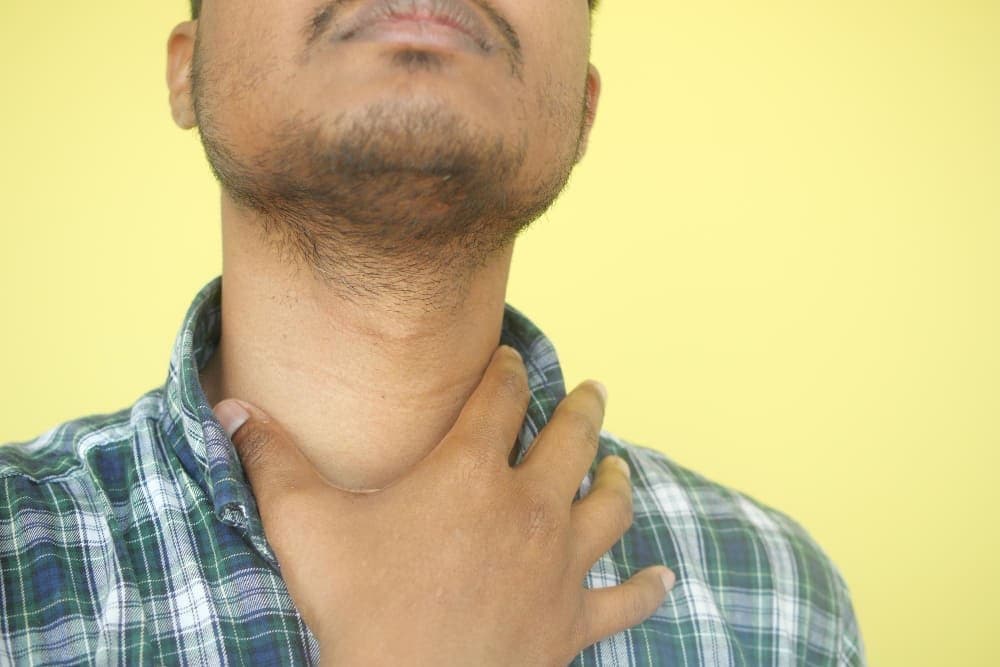Radiofrequency ablation for a thyroid nodule is a safe and minimally invasive procedure that shrinks or destroys the lump in the thyroid without the need for surgery. It offers quick recovery, no neck scar, and preserves healthy thyroid function. 🌿

Understanding Thyroid Nodules
Thyroid nodules are lumps or growths in the thyroid gland, located at the front of your neck. They can be solid or fluid-filled, and while most are benign (non-cancerous), some can grow large enough to cause symptoms.
Common symptoms of thyroid nodules include:
- Visible swelling in the neck
- Difficulty swallowing or a “lump in the throat” feeling
- Hoarseness or voice changes
- Discomfort or pressure in the neck
- Cosmetic concerns
The size of thyroid nodules often determines whether treatment is needed. Small nodules that don’t cause symptoms are usually just monitored. Larger or symptomatic nodules may require removal or shrinking.
What Is Radiofrequency Ablation (RFA)?
Radiofrequency ablation of thyroid nodules is a minimally invasive procedure that uses heat generated by radio waves to destroy abnormal thyroid tissue. It’s done under ultrasound guidance to precisely target the nodule while avoiding damage to surrounding tissue.
How radiofrequency ablation of thyroid nodules works:
- A thin needle-like probe is inserted into the nodule through the skin.
- Radio waves create thermal energy at the probe tip.
- The heat destroys the targeted cells, causing the nodule to shrink over time.
- The rest of the thyroid gland remains untouched and functioning.
Radiofrequency Ablation Thyroid Nodules Guidelines
International guidelines, such as those from the Korean Society of Thyroid Radiology (KSThR) and supported by several European interventional radiology societies, recommend RFA for:
- Benign thyroid nodules confirmed by two benign cytology results from fine-needle aspiration or core-needle biopsy
- Nodules that cause symptoms (swallowing difficulty, cosmetic concerns, pressure)
- Patients seeking a less invasive alternative to surgery
- Nodules showing progressive growth during follow-up
- Cystic or solid nodules where aspiration alone has not worked
The procedure should be performed by trained specialists using high-resolution ultrasound and the moving-shot technique to ensure complete and safe ablation.
Radiofrequency Ablation Thyroid Nodule Side Effects
Radiofrequency ablation (RFA) for thyroid nodules is generally considered safe when performed by an experienced interventional radiologist. However, like any medical procedure, it can have potential side effects. Most are mild and temporary:
- Bruising around the treated area
- Mild pain at the site where the probe was inserted
- Neck discomfort or swelling for a few days after the procedure
- Temporary difficulty swallowing due to swelling of the treated tissue
- Voice changes (hoarseness), usually temporary and caused by irritation near the vocal cord nerves
- Rarely, skin burns or numbness in the treated area may occur if the heat affects nearby nerves or skin
These side effects are typically short-term and resolve without long-term impact. Serious complications are extremely rare when RFA is done with ultrasound guidance and proper safety measures.
Why Choose RFA Over Surgery?

Traditional surgical removal (thyroidectomy or lobectomy) requires general anesthesia, a hospital stay, and leaves a neck scar. It may also lead to lifelong thyroid medication if too much tissue is removed.
RFA offers a non-invasive alternative:
- Scarless – No large incision
- Preserves thyroid function
- Lower complication rates than surgery
- Local anesthesia – No general anesthesia needed
- Quick recovery – Return to normal activities within days
This makes it an effective outpatient treatment and a highly attractive option for patients wishing to avoid surgery. 🌟
Who Can Benefit from RFA?
RFA is ideal for patients who:
- Have benign thyroid nodules confirmed by biopsy
- Experience symptoms like swallowing difficulties, cosmetic swelling, or voice changes
- Want to avoid surgery and its risks
- Have non-cancerous thyroid nodules that are growing or causing discomfort
- Are poor candidates for surgery due to other health issues
It is not suitable for:
- Cancerous nodules
- Patients with uncontrolled bleeding disorders
- Nodules that can’t be safely accessed by the probe
radiofrequency ablation thyroid nodule Step-by-Step
- Preparation:
- Ultrasound is used to assess the nodule and plan the approach.
- Local anesthesia is given to numb the neck area.
- Insertion of the Probe:
- A thin, sterile needle (probe) is inserted directly into the nodule.
- Ultrasound guidance ensures accurate placement.
- Radiofrequency Heating:
- The probe delivers radiofrequency energy to heat and destroy abnormal tissue.
- The thermal ablation is selective, targeting only the problematic cells.
- Completion:
- The probe is removed, and no stitches are needed.
- The patient rests briefly before going home the same day.
Radiofrequency Ablation Thyroid Nodule Safety and Effectiveness
Multiple studies show that RFA is a safe and effective way to shrink benign thyroid nodules. Most patients see a 50–90% reduction in nodule size within 6–12 months.
Safety profile:
- Minimal pain during and after the procedure
- Very low complication rates
- Rare, temporary voice changes
- Preserves healthy thyroid tissue and function
Radiofrequency ablation thyroid nodule near me! – Thyroid Ablation Clinic
Comparison With Other Treatments
Radioactive iodine (RAI) is sometimes used for overactive thyroid conditions, but it’s not effective for large, solid, non-cancerous nodules.
Surgery removes the nodule entirely, but with a higher risk and longer recovery.
RFA sits in between – it’s a less invasive alternative that effectively treats benign nodules without the downsides of surgery or unnecessary RAI.
Radiofrequency Ablation Thyroid Nodule Cost
Cost depends on:
- Location (UK, Europe, Middle East, etc.)
- Clinic type (private vs hospital)
- Nodule size/complexity
- Extra services (biopsy, labs)
UK range: £2,500–£5,000 per procedure.
Often cheaper than surgery when factoring in hospital stay, anesthesia, and medications.
Radiofrequency Ablation Thyroid Nodule Recovery and What to Expect
- Immediately after: Mild neck discomfort or swelling
- First few days: Return to normal activities; avoid heavy exertion for 1–2 days
- First month: Nodule begins to shrink; symptoms gradually improve
- Long-term: Continued size reduction, improved swallowing, and better neck appearance
Follow-up ultrasound scans track progress and ensure the nodule is shrinking as expected.
Why Dr. Samir Abdel Ghaffar?
As an interventional radiology consultant, Dr. Samir Abdel Ghaffar specializes in radiofrequency ablation of thyroid nodules. His clinic uses advanced ultrasound-guided equipment and a patient-centered approach to ensure safety, comfort, and excellent results.
Patients trust Dr. Samir because he:
- Has extensive RFA experience
- Provides clear explanations and realistic expectations
- Focuses on preserving thyroid health and avoiding unnecessary surgery
- Offers outpatient care with minimal disruption to daily life 💙
Conclusion: A Modern Option Worth Considering
Radiofrequency ablation is transforming benign thyroid nodule treatment. Safe, effective, and minimally invasive, it lets patients avoid surgery, scars, and long recoveries.
If you have a thyroid nodule affecting your health or confidence, RFA may be your best option. Book a consultation with Dr. Samir Abdel Ghaffar to learn how this advanced technique can help. 🌼
📞 Contact: [442081442266+]



